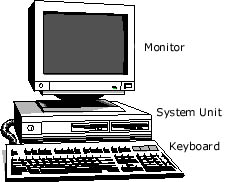HOME
|
Computer Fundamentals First step towards the world of computers........... Glossary
|
 |
| Figure 2. This diagram describes the relationships between the components of the computer system. |
The microprocessor is an integrated circuit that contains transistors, diodes, resistors, and other components interconnected to form the electronic circuit. The circuit is mounted in a metal or plastic package and connections are welded to external pins. The circuit can be accessed only through these pins. This design produces the following benefits:
a reduction in size, cost, and power consumption;
an increase in operating speed;
a higher reliability.
Large computer systems can have many processors, so they are called multiprocessor systems. The microcomputer is a system with a single processor that fits on a single chip. This processor is called a microprocessor.
The RAM and ROM chips provide memory to the computer. One of the most important characteristics of memory is the amount of information it can hold.
The input/output(I/O) devices are external devices (in relation to the CPU) that are connected to the computer to provide means of the communication between the user and the computer.
Disks (floppy, hard, or optical) and tapes are used to store information for long periods of time.
Peripheral devices are connected to the computer through ports, or sockets, that are mounted outside. Some peripherals (e.g. disk drives) are located inside the computer case, so they are connected via expansion slots.
|
b). Expansion slots
|
Figure 3. How peripheral devices are connected to the computer
Common Components
The good news is that all computers have certain common components. What makes each one different are the specifications of the components, the amount and type of memory installed, the hard drive capacity, and the additional components installed, which you decide on, that enhance the function of the computer. Every computer must have a few essential components.
Main Components
The three main components of a personal computer:
| 1. System Unit
2. Monitor 3. Keyboard |
|
The System Unit
| The system unit is the entire computer as a whole. This includes the case and all the hardware that is installed inside. The rest of these pages will cover what is contained in the system unit.Powerful electronic circuitry that makes up the computer is housed inside the case. The case can be opened by unscrewing the case screws and sliding off the cover. To avoid |




